Ruta de navegación
Blogs
Entradas con etiqueta climate change .
![Flood rescue in the Afghan village of Jalalabad, in 2010 [NATO] Flood rescue in the Afghan village of Jalalabad, in 2010 [NATO]](/documents/10174/16849987/climate-refugees-blog.jpg)
▲ Flood rescue in the Afghan village of Jalalabad, in 2010 [NATO]
ESSAY / Alejandro J. Alfonso
In December of 2019, Madrid hosted the United Nations Climate Change Conference, COP25, in an effort to raise awareness and induce action to combat the effects of climate change and global warming. COP25 is another conference in a long line of efforts to combat climate change, including the Kyoto Protocol of 2005 and the Paris Agreement in 2016. However, what the International Community has failed to do in these conferences and agreements is address the issue of those displaced by the adverse effects of Climate Change, what some call “Climate Refugees”.
Introduction
In 1951, six years after the conclusion of the Second World War and three years after the creation of the State of Israel, a young organization called the United Nations held an international convention on the status of refugees. According to Article 1 section A of this convention, the status of refugee would be given to those already recognized as refugees by earlier conventions, dating back to the League of Nations, and those who were affected “as a result of events occurring before 1 January 1951 and owing to well-founded fear of being persecuted for reasons of race, religion, nationality, membership of a particular social group or political opinion…”. However, as this is such a narrow definition of a refugee, the UN reconvened in 1967 to remove the geographical and time restrictions found in the 1951 convention[1], thus creating the 1967 Protocol.
Since then, the United Nations General Assembly and the UN High Commissioner for Refugees (UNHCR) have worked together to promote the rights of refugees and to continue the fight against the root causes of refugee movements.[2] In 2016, the General Assembly made the New York Declaration for Refugees and Migrants, followed by the Global Compact on Refugees in 2018, in which was established four objectives: “(i) ease pressures on host countries; (ii) enhance refugee self-reliance; (iii) expand access to third country solutions; and (iv) support conditions in countries of origin for return in safety and dignity”.[3] Defined as ‘interlinked and interdependent objectives’, the Global Compact aims to unite the political will of the International Community and other major stakeholders in order to have ‘equitalized, sustained and predictable contributions’ towards refugee relief efforts. Taking a holistic approach, the Compact recognizes that various factors may affect refugee movements, and that several interlinked solutions are needed to combat these root causes.
While the UN and its supporting bodies have made an effort to expand international protection of refugees, the definition on the status of refugees remains largely untouched since its initial applications in 1951 and 1967. “While not in themselves causes of refugee movements, climate, environmental degradation and natural disasters increasingly interact with the drivers of refugee movements”.3 The United Nations Intergovernmental Panel on Climate Change (IPCC) has found that the increase of the average temperature of the planet, commonly known as Global Warming, can lead to an increase in the intensity and occurrence of natural disasters[4]. Furthermore, this is reinforced by the Internal Displacement Monitoring Centre, which has found that the number of those displaced by natural disasters is higher than the number of those displaced by violence or conflict on a yearly basis[5], as shown in Table 1. In an era in which there is great preoccupation and worry concerning the adverse effects of climate change and global warming, the UN has not expanded its definition of refugee to encapsulate those who are displaced due to natural disasters caused by, allegedly, climate change.
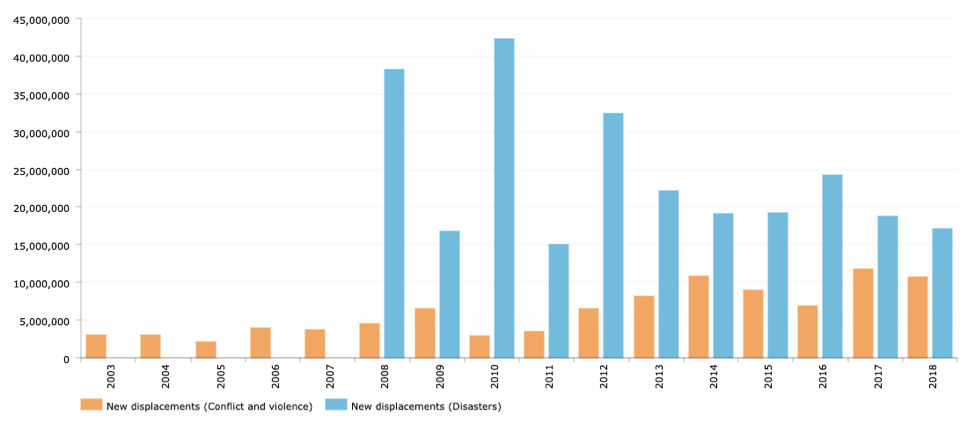
Table 1 / Global Internal Displacement Database, from IDMC
Methodology
This present paper will be focused on the study of Central America and Southeast Asia as my study subjects. The first reason for which these two regions have been selected is that both are the first and second most disaster prone areas in the world[6], respectively. Secondly, the countries found within these areas can be considered as developing states, with infrastructural, economic, and political issues that can be aggravating factors. Finally, both have been selected due to the hegemonic powers within those hemispheres: the United States of America and the People’s Republic of China. Both of these powers have an interest in how a ‘refugee’ is defined due to concerns over these two regions, and worries over becoming receiving countries to refugee flows.
Central America
As aforementioned, the intensity and frequency of natural disasters are expected to increase due to irregularities brought upon by an increase in the average temperature of the ocean. Figure 1 shows that climate driven disasters in Latin America and the Caribbean have slowly been increasing since the 1970s, along with the world average, and are expected to increase further in the years to come. In a study by Omar D. Bello, the rate of climate related disasters in Central America increased by 326% from the year 1970 to 1999, while from 2000 to 2009 the total number of climate disasters were 143 and 148 in Central America and the Caribbean respectively[7]. On the other hand, while research conducted by Holland and Bruyère has not concluded an increase in the number of hurricanes in the North Atlantic, there has been an upward trend in the proportion of Category 4-5 hurricanes in the area[8] .
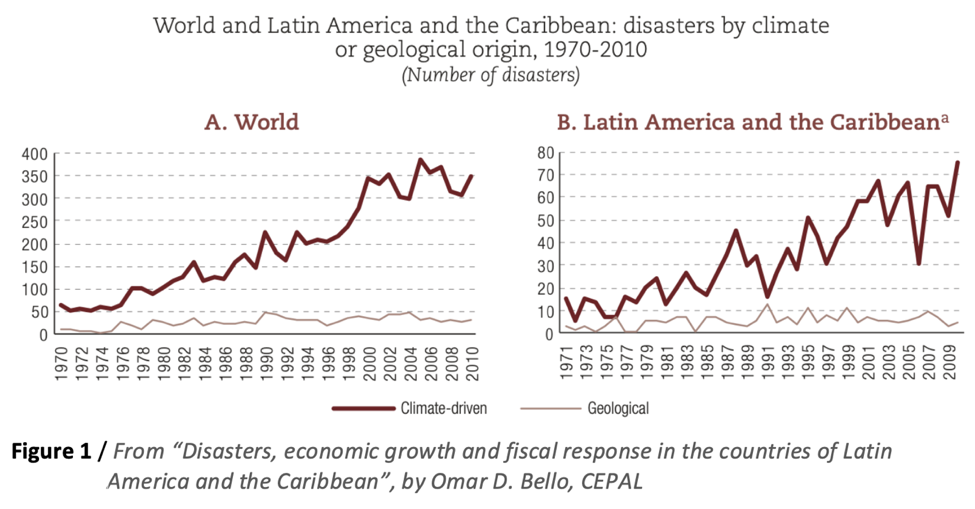
This increase in natural disasters, and their intensity, can have a hard effect on those countries which have a reliance on agriculture. Agriculture as a percentage of GDP has been declining within the region in recent years due to policies of diversification of economies. However, in the countries of Honduras and Nicaragua the percentage share of agriculture is still slightly higher than 10%, while in Guatemala and Belize agriculture is slightly below 10% of GDP share[9]. Therefore, we can expect high levels of emigration from the agricultural sectors of these countries, heading toward higher elevations, such as the Central Plateau of Mexico, and the highlands of Guatemala. Furthermore, we can expect mass migration movements from Belize, which is projected to be partially submerged by 2100 due to rising sea levels[10].
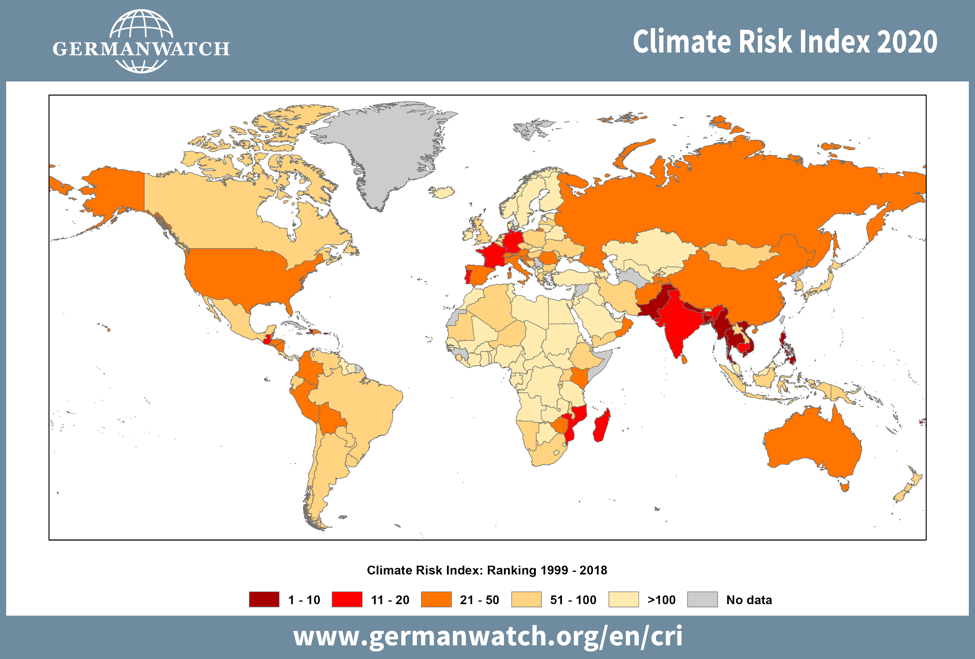
Figure 2 / Climate Risk Index 2020, from German Watch
Southeast Asia
The second region of concern is Southeast Asia, the region most affected by natural disasters, according to the research by Bello, mentioned previously. The countries of Southeast Asia are ranked in the top ten countries projected to be at most risk due to climate change, shown in Figure 2 above[11]. Southeast Asia is home to over 650 million people, about 8% of total world population, with 50% living in urban areas[12]. Recently, the OECD concluded that while the share in GDP of agriculture and fisheries has declined in recent years, there is still a heavy reliance on these sectors to push economy in the future[13]. In 2014, the Asian Development Bank carried out a study analyzing the possible cost of climate change on several countries in the region. It concluded that a possible loss of 1.8% in the GDP of six countries could occur by 2050[14]. These six countries had a high reliance on agriculture as part of the GDP, for example Bangladesh with around 20% of GDP and 48% of the workforce being dedicated to agricultural goods. Therefore, those countries with a high reliance on agricultural goods or fisheries as a proportion of GDP can be expected to be the sources of large climate migration in the future, more so than in the countries of Central America.
One possible factor is the vast river system within the area, which is susceptible to yearly flooding. With an increase in average water levels, we can expect this flooding to worsen gradually throughout the years. In the case of Bangladesh, 28% of the population lives on a coastline which sits below sea level[15]. With trends of submerged areas, Bangladesh is expected to lose 11% of its territory due to rising sea levels by 2050, affecting approximately 15 million inhabitants[16][17]. Scientists have reason to believe that warmer ocean temperatures will not only lead to rising sea levels, but also an intensification and increase of frequency in typhoons and monsoons[18], such as is the case with hurricanes in the North Atlantic.
Expected Destinations
Taking into account the analysis provided above, there are two possible migration movements: internal or external. In respect to internal migration, climate migrants will begin to move towards higher elevations and temperate climates to avoid the extreme weather that forced their exodus. The World Bank report, cited above, marked two locations within Central America that fulfil these criteria: the Central Plateau of Mexico, and the highlands of Guatemala. Meanwhile, in Southeast Asia, climate migrants will move inwards in an attempt to flee the rising waters, floods, and storms.
However, it is within reason to believe that there will be significant climate migration flows towards the USA and the Popular Republic of China (PRC). Both the United States and China are global powers, and as such have a political stability and economic prowess that already attracts normal migration flows. For those fleeing the effects of climate change, this stability will become even more so attractive as a future home. For those in Southeast Asia, China becomes a very desired destination. With the second largest land area of any country, and with a large central zone far from coastal waters, China provides a territorial sound destination. As the hegemon in Asia, China could easily acclimate these climate migrants, sending them to regions that could use a larger agricultural workforce, if such a place exists within China.
In the case of Central America, the United States is already a sought-after destination for migrant movements, being the first migrant destination for all Central American countries save Nicaragua, whose citizens migrate in greater number to Costa Rica[19]. With the world’s largest economy, and with the oldest democracy in the Western hemisphere, the United States is a stable destination for any refugee. In regard to relocation plans for areas affected by natural disasters, the United States also has shown it is capable of effectively moving at-risk populations, such as the Isle de Jean Charles resettlement program in the state of Louisiana[20].
Problems
While some would opine that ‘climate migrants’ and ‘climate refugees’ are interchangeable terms, they are unfortunately not. Under international law, there does not exist ‘climate refugees’. The problem with ‘climate refugees’ is that there is currently no political will to change the definition of refugee to include this new category among them. In the case of the United States, section 101(42) of the Immigration and Nationality Act (INA), the definition of a refugee follows that of the aforementioned 1951 Geneva convention[21], once again leaving out the supposed ‘climate refugees’. The Trump administration has an interest in maintaining this status quo, especially in regard to its hard stance in stopping the flow of illegal immigrants coming from Central America. If a resolution should pass the United Nations Security Council, the Trump administration would have no choice but to change section 101(42) of the INA, thus risking an increased number of asylum applicants to the US. Therefore, it can confidently be projected that the current administration, and possibly future administrations, would utilize the veto power, given to permanent members of the United Nations Security Council, on such a resolution.
China, the strongest regional actor in Asia, does not have to worry about displeasing the voter. Rather, they would not allow a redefinition of refugee to pass the UN Security Council for reasons concerning the stability and homogeneity of the country. While China does accept refugees, according to the UNHCR, the number of refugees is fairly low, especially those from the Middle East. This is mostly likely due to the animosity that the Chinese government has for the Muslim population. In fact, the Chinese government has a tense relationship with organized religion in and of itself, but mostly with Islam and Buddhism. Therefore, it is very easy to believe that China would veto a redefinition of refugee to include ‘climate refugees’, in that that would open its borders to a larger number of asylum seekers from its neighboring countries. This is especially unlikely when said neighbors have a high concentration of Muslims and Buddhists: Bangladesh is 90% Muslim, and Burma (Myanmar) is 87% Buddhist[22]. Furthermore, both countries have known religious extremist groups that cause instability in civil society, a problem the Chinese government neither needs nor wants.
On the other hand, there is also the theory that the causes of climate migration simply cannot be measured. Natural disasters have always been a part of human history and have been a cause of migration since time immemorial. Therefore, how can we know if migrations are taking place due to climate factors, or due to other aggravating factors, such as political or economic instability? According to a report by the French think tank ‘Population and Societies’, when a natural disaster occurs, the consequences remain localized, and the people will migrate only temporarily, if they leave the affected zone at all[23]. This is due to the fact that usually that society will bind together, working with familial relations to surpass the event. The report also brings to light an important issue touched upon in the studies mentioned above: there are other factors that play in a migration due to a natural disaster. Véron and Golaz in their report cite that the migration caused by the Ethiopian drought of 1984 was also due in part to bad policies by the Ethiopian government, such as tax measures or non-farming policies.
The lack of diversification of the economies of these countries, and the reliance on agriculture could be such an aggravating factor. Agriculture is very susceptible to changes in climate patterns and are affected when these climate patterns become irregular. This can relate to a change of expected rainfall, whether it be delayed, not the quantity needed, or no rainfall at all. Concerning the rising sea levels and an increase in floods, the soil of agricultural areas can be contaminated with excess salt levels, which would remain even after the flooding recedes. For example, the Sula Valley in Honduras generates 62% of GDP, and about 68% of the exports, but with its rivers and proximity to the ocean, also suffers from occasional flooding. Likewise, Bangladesh's heavy reliance on agriculture, being below sea level, could see salt contamination in its soil in the near future, damaging agricultural property.
Reliance on agriculture alone does not answer why natural disasters could cause large emigration in the region. Bello and Professor Patricia Weiss Fagen[24] find that issues concerning the funding of local relief projects, corruption in local institutions, and general mismanagement of crisis response is another aggravating factor. Usually, forced migration flows finish with a return to the country or area of origin, once the crisis has been resolved. However, when the crisis has continuing effects, such as what happened in Chernobyl, for example, or when the crisis has not been correctly dealt with, this return flow does not occur. For example, in the countries composing the Northern Triangle, there are problems of organized crime which is already a factor for migration flows from the area[25]. Likewise, the failure of Bangladesh and Myanmar to deal with extremist Buddhist movements, or the specific case of the Rohinga Muslims, could inhibit return flows and even encourage leaving the region entirely.
Recommendations and Conclusions
The definition of refugee will not be changed or modified in order to protect climate migrants. That is a political decision by countries who sit at a privileged position of not having to worry about such a crisis occurring in their own countries, nor want to be burdened by those countries who will be affected. Facing this simple reality should help to find a better alternative solution, which is the continuing efforts of the development of nations, in order that they may be self-sufficient, for their sake and the population’s sake. This fight does not have to be taken alone, but can be fought together through regional organizations who have a better understanding and grasp of the gravity of the situation, and can create holistic approaches to resolve and prevent these crises.
We should not expect the United Nations to resolve the problem of displacement due to natural disasters. The United Nations focuses on generalized and universal issues, such as that of global warming and climate change, but in my opinion is weak in resolving localized problems. Regional organizations are the correct forum to resolve this grave problem. For Central America, the Organization of American States (OAS) provides a stable forum where these countries may express their concerns with states of North and Latin America. With the re-election of Secretary General Luis Almagro, a strong and outspoken authority on issues concerning the protection of Human Rights, the OAS is the perfect forum to protect those displaced by natural disasters in the region. Furthermore, the OAS could work closely with the Inter-American Development Bank, which has the financial support of international actors who are not part of the OAS, such as Japan, Israel, Spain, and China, to establish the necessary political and structural reforms to better implement crisis management responses. This does not exclude the collusion with other international organizations, such as the UN. Interestingly, the Organization of the Petroleum Exporting Countries (OPEC) has a project in the aforementioned Sula Valley to improve infrastructure to deal with the yearly floods[26].
The Association of Southeast Asian Nations (ASEAN) is another example of an apt regional organization to deal with the localized issues. Mostly dealing with economic issues, this forum of ten countries could carry out mutual programs in order to protect agricultural territory, or further integrate to allow a diversification of their economies to ease this reliance on agricultural goods. ASEAN could also call forth the ASEAN +3 mechanism, which incorporates China, Japan, and South Korea, to help with the management of these projects, or for financial aid. China should be interested in the latter option, seeing as it can increase its good image in the region, as well as protecting its interest of preventing possible migration flows to its territory. The Asian Development Bank, on the other hand, offers a good alternative financial source if the ASEAN countries so choose, in order to not have heavy reliance on one country or the other.
[1]https://www.unhcr.org/about-us/background/4ec262df9/1951-convention-relating-status-refugees-its-1967-protocol.html
[2]https://www.unhcr.org/
[3]https://www.unhcr.org/new-york-declaration-for-refugees-and-migrants.html
[4]https://www.ipcc.ch/site/assets/uploads/2018/03/SREX_Full_Report-1.pdf
[5]https://www.internal-displacement.org/database/displacement-data
[6]https://reliefweb.int/report/world/natural-disasters-latin-america-and-caribbean-2000-2019
[7]https://repositorio.cepal.org/bitstream/handle/11362/42007/1/RVI121_Bello.pdf
[8]https://link.springer.com/content/pdf/10.1007/s00382-013-1713-0.pdf
[9]https://www.indexmundi.com/facts/indicators/NV.AGR.TOTL.ZS/map/central-america
[10]https://www.caribbeanclimate.bz/belize-most-vulnerable-in-central-america-to-sea-level-rise/
[11]https://germanwatch.org/en/17307
[12]https://www.worldometers.info/world-population/south-eastern-asia-population/
[13]http://www.fao.org/3/a-bt099e.pdf
[14]https://www.adb.org/sites/default/files/publication/42811/assessing-costs-climate-change-and-adaptation-south-asia.pdf
[15]https://www.nrdc.org/onearth/bangladesh-country-underwater-culture-move
[16]https://www.dw.com/en/worst-case-scenario-for-sea-level-rise-no-more-new-york-berlin-or-shanghai/a-18714345
[17]https://ejfoundation.org/reports/climate-displacement-in-bangladesh
[18]https://www.climatecentral.org/news/warming-increases-typhoon-intensity-19049
[19]https://www.migrationpolicy.org/article/central-american-immigrants-united-states
[20] http://isledejeancharles.la.gov/
[21]https://uscode.house.gov/view.xhtml?req=granuleid:USC-prelim-title8-section1101&num=0&edition=prelim
[22]https://www.cia.gov/library/publications/resources/the-world-factbook/
[23]https://www.ined.fr/fichier/s_rubrique/23737/population.societes.2015.522.migration.environmental.en.pdf
[24]https://reliefweb.int/sites/reliefweb.int/files/resources/D4B04197663A2846492575FD001D9715-Full_Report.pdf
[25]https://www.refugeesinternational.org/reports/2017/11/27/displacement-and-violence-in-the-northern-triangle?gclid=CjwKCAjwmKLzBRBeEiwACCVihjauFsYr3zo1g-3g3Ry9WfQzr7wwO7cOGID1Ksdh5L5mOSSY_55GuBoCmfAQAvD_BwE
[26]https://opecfund.org/operations/list/sula-valley-flood-protection-project
The UN Conference did little to increase international commitment to climate change action, but did at least boost the assertiveness of the EU
In recent years, the temperature of the Earth has risen, causing the desertification of lands and the melting of the Poles. This is a major threat to food production and provokes the rise of sea levels. The Intergovernmental Panel on Climate Change (IPCC) has concluded that there is a more than 95% probability that human activities over the past 50 years are the cause of global warming. Since 1995 the United Nations has organized international meetings in order to coordinate measures to reduce CO2 emissions, which arguably are behind the increases in temperature. The latest meeting was the COP25, which took place in Madrid this past December. The COP25 could be labeled almost a missed opportunity.

ARTICLE / Alexia Cosmello and Ane Gil
The Intergovernmental Panel on Climate Change (IPCC) was established in 1988 by the World Meteorological Organization (WMO) and United Nations Environment Programme. The IPCC’s Fifth Assessment Report concluded that: “Climate change is real and human activities are the main cause.” In recent years, rising temperatures on earth have contributed to the melting of the Polar Ice Cap and an increase in desertification. These developments have provoked the rise of sea levels and stresses on global food production, respectively.
In 1992, the IPCC formed the United Nations Framework Convention on Climate Change (UNFCCC) with the goal of minimizing anthropogenic damage to the earth’s climate. 197 countries have since ratified the UNFCCC, making it nearly universal. Since 1995, the UNFCCC has held an annual Conference of the Parties (COP) to combat climate change. These COPs assess the progress of national governments in managing the climate crisis, and establish the legally binding obligations of developed countries to combat climate change. The most significant international agreements emerging from UNFCCC annual COPs are the Kyoto Protocol (2005) and the Paris Agreement (2016). The most recent COP25 (25th Conference of the Parties to the United Nations Framework Convention on Climate Change (UNFCCC) took place in Madrid in December 2019.
The previous conference (COP24) marked a significant improvement in international regulation for implementing the Paris Agreement, but crucially ignored the issue of carbon markets (Article 6). Thus, one of the main objectives of COP25 was the completion of an operating manual for the Paris Accords that included provisions for carbon market regulation. However, COP25 failed to reach a consensus on carbon market regulation, largely due to opposition from Brazil and Australia. The issue will be passed onto next year’s COP26.
Another particularly divisive issue in COP25 was the low level of international commitment. In the end, only 84 countries committed to the COP25 resolutions; among them we find Spain, the UK, France and Germany. Key players such as the US, China, India and Russia all declined to commit, perhaps because together they account for 55% of global CO2 emissions. All states will review their commitments for COP26 in 2020, but if COP26 goes anything like COP25 there will be little hope for positive change.
COP25 also failed to reach an agreement on reimbursements for damage and loss resulting from climate change. COP15 set the goal of increasing the annual budget of the Green Climate Fund to 100 billion USD by 2020, but due to the absence of sufficient financial commitment in COP25, it appears that this goal will not be met.
It is worth noting that in spite of these grave failures, COP25 did achieve minor improvements. Several new policies were established and a variety of multilateral agreements were made. In terms of policies, COP25 implemented a global “Gender Action Plan,” which will focus on the systematic integration of gender equality into climate policies. Additionally, COP25 issued a declaration calling for increased consideration of marine biodiversity. In terms of multilateral agreements, many significant commitments were made by a vast array of countries, cities, businesses, and international coalitions. Notably, after COP25, the Climate Ambitious Coalition now counts with the impressive support of 27 investors, 763 companies, 393 cities, 14 regions, and 70 countries.
But by far the saving grace of COP25 was the EU. The EU shone brightly during COP25, acting as a example for the rest of the world. And this is nothing new. The EU has been a forerunner in climate change action for over a decade now. In 2008, the EU established its first sustainability goals, which it called the “2020 Goals”. These goals included: reducing GHG emission by 20% (compared to 1990), increasing energy efficiency by 20%, and satisfying a full 20% of total energy consumption with renewable energy sources. To date, the EU has managed not merely to achieve these goals, but to surpass them. In fact, by 2017, EU GHG emissions had been reduced not just by 20%, but by 22%.
The EU achieved these lofty goals because it backed them up with effective policies. Note:
i) The launch by the EU Commission in June 2000 of the European Climate Change Programme (ECCP). Its main goal is to identify and develop all the necessary elements of an EU strategy to implement the UN Kyoto Protocol of COP3.
ii) The EU ECCP developed the ETS (EU emissions trading system), which has helped to reduce greenhouse gas emissions from energy-intensive industries and power plants.
iii)The EU adopted revised rules for the ETS in February 2018, which set the limits on CO2 emissions of heavy industry and power stations.
iv)The EU opted for a “circular economy.” In May 2018, the EU decided on new rules for waste management and established legally binding targets for recycling. In May 2019, the EU adopted a ban on single-use plastic items.
v) The EU limited CO2 emissions on the roads. In April 2019, stricter emission limits for cars and vans were passed. By 2029, both cars and vans will be required to emit on average 15% less CO2.
vi) The EU approved new regulations in May 2018 for improved protection and management of lands and forests.
If the EU is anywhere near as successful at combating climate change in the decades to come as it has proved itself to be in the past decade, the EU seems primed to achieve both its 2030 Goals, and its 2050 Goals (the European Green Deal). The 2030 Goals include cutting GHG emissions by at least 40% by 2030 (compared to 1990). Such new measures will make the EU’s economy and energy systems more competitive, more secure, and more sustainable. The 2050 Goals are even more ambitious: they include the complete elimination all CO2 emissions and the achievement of a climate-neutral EU by 2050. The EU’s 2030 and 2050 Goals, if achieved, will be a remarkable step in the right direction towards achieving the Paris Agreement objective to keep global temperature increase stabilized at 1.5ºC and well below 2ºC.
The European Green Deal and 2030 and 2050 Goals will demand far more effort than the 2020 Goals, especially in the political and economic spheres. Poland has yet to commit to the Deal, which has led the European Council to postpone the matter until June 2020. But progress in the EU towards the 2050 Goals is already underway. The Just Transition Mechanism was proposed in December 2019 to provide support for European regions projected to be most affected by the transition to climate neutrality. (This measure will also hopefully serve to assuage the concerns of Poland and other members.) The EU Commission is to prepare a long-term strategy proposal as early as possible in 2020 with the intention of its adoption by the Council and its submission to the UNFCCC shortly thereafter. Furthermore, the EU Commission has also been tasked with a proposal, after a thorough impact assessment, for an update of the EU’s nationally determined contribution for 2030 under the Paris Agreement. The EU’s example is reason to hope for a bright and sustainable future for the developed world.
Unfortunately, not every developed country is as committed to sustainability as the EU. While many efforts have been made at both the global and regional levels to combat climate change, it is abundantly clear that these efforts are horrendously insufficient. In order to properly address climate change, consistent commitment to sustainability from all parties is imperative. Those countries such as the US, China, India and Russia that abstained from commiting to the COP25 resolutions need to begin following in the EU’s sustainable footsteps and start behaving like true global citizens as well. If they do not, even the EU’s exemplary efforts will not be anywhere near enough to slow climate change.
The thaw has caused the release of icebergs that may be a risk to navigation, but in Antarctica the geopolitics is partially frozen
The increase of the temperatures is opening the Arctic to the commercial routes and to the dispute between countries for the future control of the riches of its subsoil. In Antarctica, with lower temperatures and a slower thaw, what is under the white mantle is not an ocean, but a continent away from the navigation lines and the direct interests of the great powers. There are reasons for the main international actors to prefer to continue leaving in the fridge all claims about the South Pole.
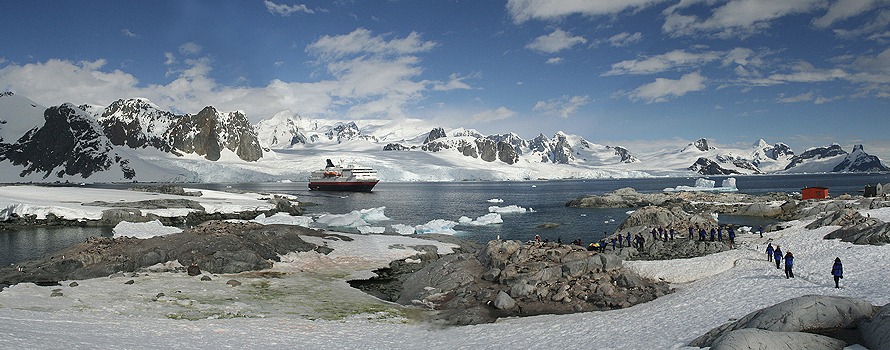
ARTICLE / Alona Sainetska [Spanish version]
Antarctica is a continent with mountain ranges and lakes, surrounded by an ocean and with a total area of 14 million square kilometers. It is often compared to the Arctic which is, instead, an icy sea surrounded by land. In the north of the Arctic Circle live about 4 million people. In contrast, the Antarctica, with its average of -49° C of temperature, is absolutely uninhabitable and is considered today as a natural sanctuary that attracts the attention of numerous countries from all over the world.
Even though the South Pole does not present, at a first glimpse, any important elements for a conflict in the global, international system, the sovereignty of its territory has never been exempt from disputes and territorial claims by countries such as the United Kingdom, Australia, New Zealand, Norway, France, Argentina and Chile. Although lately they were left in abeyance, the claims of those countries do not interfere with others, except in the case of Argentina and Chile, whose claims were made on the parts of the land that have already been requested totally or partially by England.
In this context there has occurred a transcendental coincidence of interests among the aforementioned countries which also spread to the non-claiming superpowers, as was the case of the United States and the USSR. Both showed little desire to convert the continent and the maritime space into an object of political-military clashes. This fact facilitated a lot the negotiations about the future legal status that would have "the frozen continent".
The first attempt to establish a special legal regime for Antarctica was the initiative of the United States, in 1948. However, this idea failed while clashing with the opposition of countries that wished to expand their sovereignty to the territories of Antarctica. Only two years later, when the USSR announced that it would not accept any agreement on Antarctica in which it was not represented, could the continent arouse interest of the great powers once again.
Facing the need of reaching a consensus and as a result of the enormous efforts of the world scientific community, a climate of cooperation and international dialogue on Antarctica was born. This allowed free access of scientists of any nationality to the continent, as well as the exchange of the results of their investigations.
This new context led to the signature of the Treaty on Antarctica (ATS), on December 1, 1959 , which entered into force on June 23, 1961. Any possible modification, by majority, was postponed until a conference scheduled for 30 years after its enforcement. However, when 1991 arrived, there were no changes applied and, what is even more, the safeguards were added.
In the AT, the member-countries committed themselves to recognize a special legal regime of Antarctica, giving it a status of "terra nullius". In addition, there was established a demilitarization of the Antarctic continent, which reserved the frozen space exclusively for peaceful purposes and prohibited the foundation of military bases.
On the other hand, it proclaimed the freezing of all claims of territorial sovereignty over Antarctica, not allowing either making new claims or expanding those previously made during the period of validity of the treaty.
In the same way, there was originated a right to appoint observers in order to ensure fulfillment of the objectives of the treaty and, additionally, there were organized some periodic meetings for both the original signatory states and those being assigned a consultative function for carrying out important scientific missions in Antarctica.
Scientific and economic potential
In 1991, there were some additional efforts made in the conservation of the frozen giant. In order to respond to issues such as climate change and the need to protect the special ecosystem that the continent represented, the so-called "complementary" protocol to the AT on environmental protection was signed in Madrid. The requisite for its entry into force was the obligation to be ratified by all the Antarctic Treaty consultative members.
It put under prohibition any exploitation of mineral resources, except those carried for scientific purposes. This restriction could only be lifted by unanimous agreement and kept the continent away from possible plunder of its great natural resources. Antarctica thus became a unique place in the world where the coexistence between man and nature could be possible and long-lasting.
However, the last decades supposed many strategic changes that have caused serious doubts and concerns regarding the effectiveness of the AT. Antarctica’s scientific and economic potential, together with its enormous biodiversity and richness in natural resources, have greatly increased its importance. The greater interaction and interdependence of the numerous national, international and transnational actors that form the world community has also multiplied the desire to influence and participate, in different ways, in the pursuit of particular interests in this area of the world.
Thus, not only there are projects aimed to guarantee environmental conditions, such as discussion on the creation of a large area of natural preservation in the Ross Sea, but also some controversial initiatives in order to take advantage of Antarctic resources. One example could be a recent suggestion of the Arab Emirates to tow icebergs from the masses of Antarctic ice towards the Middle East, in order to combat drought and meet the needs of its population (Antarctica contains 80% of the planet's freshwater reserves).
These icebergs, on the other side, can present a tremendous threat to navigation and commerce, especially in the case of the large ones, such as Larsen C, which is every day increasingly closer to a collapse. The consequences may be tragic - a huge iceberg of 5,800 square kilometres left adrift.
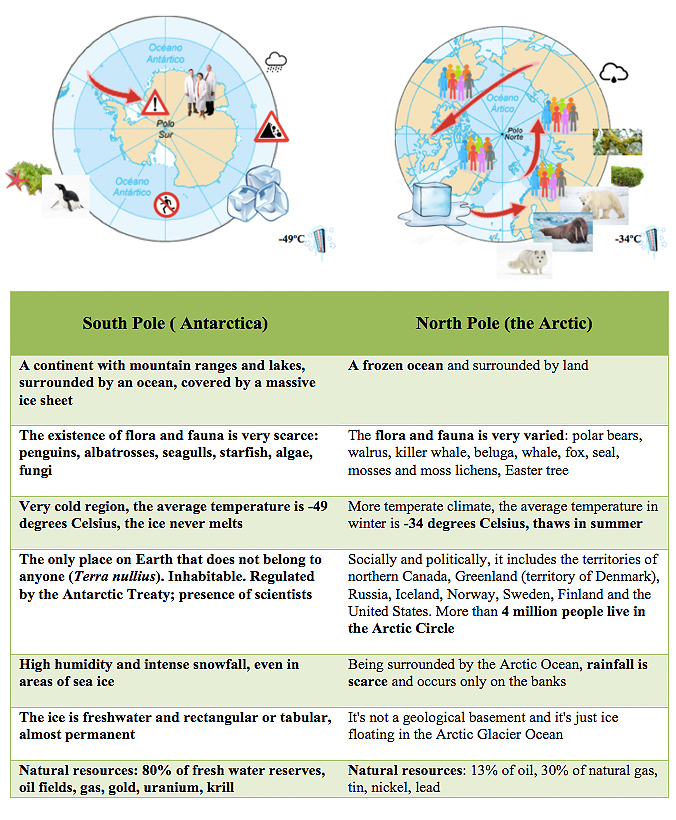 |
Countries with different weight
Although, due to the disadvantages resulting from the remoteness of the continent and its harsh and unfavourable conditions, a possible exploitation of Antarctica is not foreseen for the short run and remains now more hypothetical rather than real, there is still a risk of future deployment of economic activity in the Antarctic region worldwide.
The latter will depend on international alignments that may arise.
The alignments in relation to the Antarctica follow the administration structure imposed by the Treaty, which includes three categories of members:
-
The original signatories (Argentina, Australia, Belgium, Chile, France, Japan, New Zealand, Norway, South African Republic, Soviet Union, Great Britain and the United States) participating in a full right in the consultative meetings of the AT where decisions are made.
-
Those States that wish to join and, having developed activities important scientists, obtain the consent to participate in the Consultative meetings (for example: Poland, Germany, India, Brazil, China and Uruguay).
-
Finally, the States that adhere, but, because of not carrying out a significant scientific activity, cannot participate in decision-making (Czechoslovakia, Cuba, Hungary, Bulgaria, Peru, Italy, New Guinea, Spain, Sweden, the Netherlands, Denmark, Romania and Finland).
A similar situation of collision of interests among the international actors is evident at the opposite pole of the Earth, the Arctic. Its climatic conditions have much warmer temperatures that allow the melting of its sensitive layer of ice. So, the thaw caused by the global warming makes the Arctic's energy wealth more and more accessible (it is estimated that it harbours 13% of the oil and 30% of the natural gas that remains in the planet). As a direct consequence of that, the struggle for gaining rights to exploit it is being intensified between countries such as, Denmark, Canada, the United States, Norway and Russia.
On the other hand there is China, for which the thawing has a lot of positive consequences, such as the opening of new inter-oceanic navigation routes between northern Europe and much shorter Shanghai, or easier access to mining areas like Greenland.
In light of the above considerations (the abundance of essential minerals in technology, the opening of new routes or maritime transport and the fact that the lands located in the Arctic Circle are habitable, along with benevolent conditions and easier access), it is very likely that the Arctic may be integrated into the world economic structure much sooner than Antarctica.
